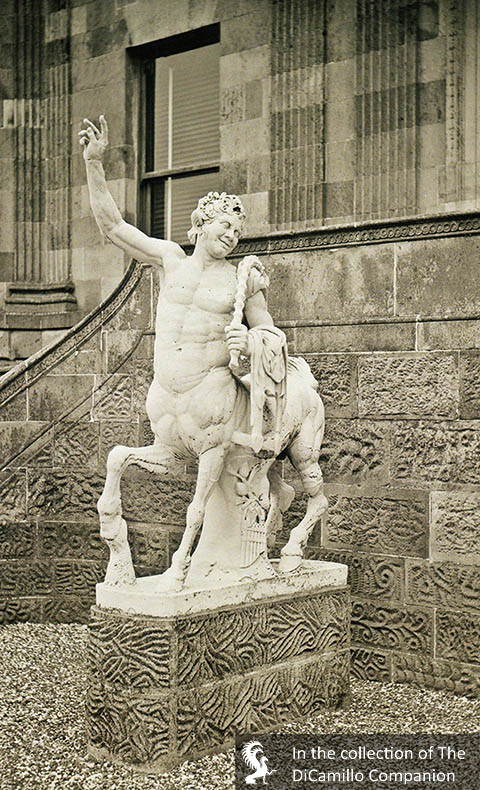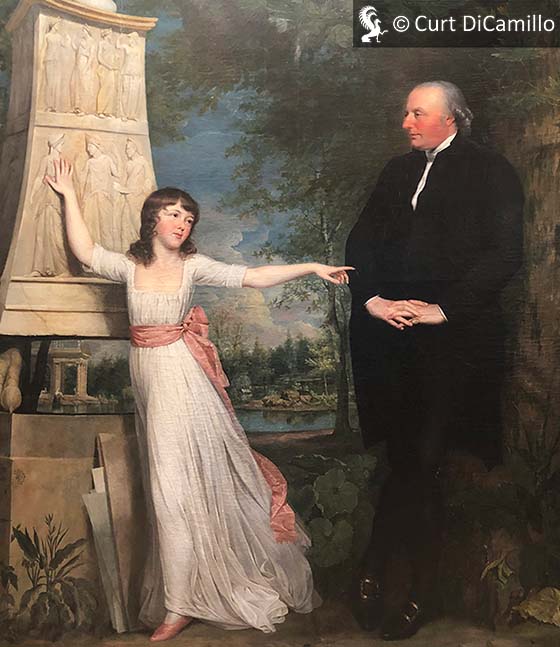
An early 19th century view of the house, with the Mussenden Temple on the far left, from "Neale's Views of Seats."

Statue of a centaur in front of the house from a circa 1900 photograph

This circa 1790 painting by Hugh Douglas Hamilton, today in the collection of the National Gallery of Ireland, shows the builder of Downhill, Frederick Hervey, Bishop of Derry and 4th Earl of Bristol, with his granddaughter, Lady Caroline Crichton, in the gardens of the Villa Borghese in Rome.
Built / Designed For: Frederick Augustus Hervey, Earl of Bristol and Bishop of Derry
House & Family History: The Downhill House was built for Frederick Augustus Hervey (1730-1803), the famous earl-bishop (4th Earl of Bristol and Bishop of Derry), using, in part, revenue from the bishopric of Derry to finance construction of the house (in the 18th century the Diocese of Derry was the second-richest bishopric in Ireland). The earl-bishop's architect was Michael Shanahan, an Irish master mason-turned architect, who probably followed plans originally made by James Wyatt. On the exterior Downhill featured domes and fluted Corinthian pilasters, while the interior boasted a two-story picture gallery and a lobby supported by four columns of Derbyshire marble. After a severe 1851 fire the house was rebuilt in the 1870s on a slightly different, smaller, plan. During World War II Downhill House was used to billet RAF servicemen and women. The Bruce family sold the house and estate in 1946 and the house's roof was removed in 1950, which, inevitably led it to become a ruin. Downhill House was acquired by the National Trust in 1980 (Mussenden Temple had had been owned by the trust since the 1940s). The earl-bishop was a great collector of paintings and marbles, an inveterate traveler (Bristol Hotels, famous on the continent, were named after him), and a lover of Italy (he died there in 1803 in the outhouse of a peasant's cottage near Rome because the owner didn't want a Protestant heretic to die under his roof). At his death the earl-bishop bequeathed Downhill to his relation Henry Bruce, who made the house his seat. The earl-bishop's other house in Ireland was Ballyscullion, a great domed house that has completely vanished. Ickworth House, the earl-bishop's domed English seat in Suffolk, remains today as a reminder of its Irish cousin. An Italian chimneypiece from Downhill (probably originally from Ballyscullion) is today at Castle Upton in Co. Antrim.
Collections: Though the 1851 fire destroyed paintings by Rubens, Dürer, Correggio, Tintoretto, and Murillo, the majority of the collection was saved.
Garden & Outbuildings: The grounds were laid out in the 18th century by the earl-bishop and are today owned by the National Trust as part of the Downhill & Mussenden Temple Estate. The famous Mussenden Temple, perched dramatically on a cliff overlooking the Atlantic, is open on certain days, and admission is free. The inscription from Lucretius around the Temple frieze reads "Tis pleasant, safely to behold from shore / The rolling ship, and hear the tempest roar." The earl-bishop was exceedingly opened-minded and allowed Catholics to celebrate Mass in the room under the Mussenden Temple (in his will he dictated that this practice should be allowed to continue after his death). Also on the estate today is the Gateway, the ruins of the house, the gardens, the domed Mausoleum (built by the earl-bishop in memory of his brother), woodland and cliff walks, a fish pond, and family memorials.
Architect: John Lanyon
Date: 1870-74Architect: Michael Shanahan
Date: Circa 1776-79Architect: James Wyatt
Date: 1770sJohn Preston (J.P.) Neale, published under the title of Views of the Seats of Noblemen and Gentlemen in England, Wales, Scotland, and Ireland, among other titles: Vol. VI, 1823.
Country Life: CVII, 34, 1950. CL, 94, 154 plan, 1971.
Title: Houses of Ireland: Domestic Architecture from the Medieval Castle to the Edwardian Villa, The
Author: de Breffny, Brian; ffolliott, Rosemary; Mott, George
Year Published: 1975
Reference: pgs. 166-168
Publisher: New York: Viking Press
ISBN: 670381020
Book Type: Hardback
Title: Biographical Dictionary of British Architects, 1600-1840, A - SOFTBACK
Author: Colvin, Howard
Year Published: 1995
Reference: pg. 1115
Publisher: New Haven: Yale University Press
ISBN: 0300072074
Book Type: Softback
Title: Cadogan Ireland
Author: Day, Catharina
Year Published: 1998
Publisher: London: Cadogan Guides
ISBN: 1860110886
Book Type: Softback
House Listed: Unknown
Park Listed: Unknown
Past Seat / Home of: Frederick Augustus Hervey, 4th Earl of Bristol and Bishop of Derry, 1779-1803. The Rev. Henry Bruce, early 19th century; Bruce family here until 1946.
Current Ownership Type: The National Trust
Primary Current Ownership Use: Visitor Attraction
Ownership Details: The grounds encompassing Mussenden Temple and Downhill House are open to the public all year from dawn to dusk.
House Open to Public: Grounds Only
Phone: 02870-848-728
Fax: 02870-848-728
Email: [email protected]
Website: https://www.nationaltrust.org.uk
Historic Houses Member: No